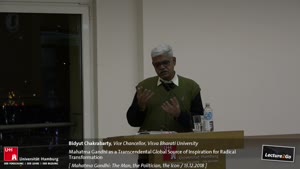Mahatma Gandhi as a Transcendental Global Source of Inspiration for Radical Transformation - Prof. Dr. Bidyut Chakrabarty - Universität Hamburg
- Lecture2Go
- Videokatalog
- F.5 - Geisteswissenschaften
- Asien-Afrika-Institut
- Mahatma Gandhi: The Man, the Politician, the Icon
Videokatalog
Mahatma Gandhi as a Transcendental Global Source of Inspiration for Radical Transformation
Special lecture series in six parts by Dr. Bidyut Chakrabarty, Vice Chancellor, Visva Bharati University.
As a guest at Hamburg University, Professor Bidyut Chakrabarty from the Visva Bharati University will
lecture on the life and legacy of Mahatma Gandhi. Professor Chakrabarty has published widely on Gandhi and counts as one of the world’s foremost experts on Gandhi as a freedom fighter, politician and icon for nonviolent struggle.
Popularly known as Mahatma Gandhi, Mohandas Karamchand Gandhi (1869–1948) stood out for being a stern proponent of nonviolence (ahimsa). Although he mobilized the colonized against the colonizers for political freedom, his main objective was to bring about human emancipation which involved freedom from exploitation, denigration and prejudices. By developing a contextual politicoideological design, he also demonstrated how nonviolence could be an effective mobilizing tool since nonviolence, he believed, was instinctive of human beings. It is true that Gandhi evolved a political template, based on nonviolence, which he derived from multiple Western and non-Western sources. Of all the thinkers who significantly influenced Gandhi in developing satyagraha (nonviolent struggle in Gandhi’s lexicon), Leo Tolstoy, John D Ruskin, Henry David Thoreau, Edward Carpenter, among others, were prominent; their ideas not only resonated in Gandhi’s socio-political idioms, they were critical to his conceptualization of an alternative mode of political struggle in which violence was a clear anathema.
Along with the Western intellectual antecedents, Gandhi was also indebted to his illustrious
colleagues in India’s nationalist campaign against the British. Prominent among them were the communist MN Roy, the humanist Rabindranath Tagore, and BR Ambedkar who is credited with the framing of a liberal constitution for independent India.
As an activist-theoretician, Gandhi translated his ideological commitment to nonviolence into
practice when he fought with British colonialism primarily because it deviated from the core values of the philosophy of Enlightenment which entailed benevolence, tolerance and compassion. Apart from leading three regional anti-British campaigns in Gujarat and Bihar, the Mahatma also organized three major pan-Indian onslaughts on the British 1921–22, 1930–32, and in 1942. Except in 1942, in the context of the Open Rebellion, both the past movements were strictly nonviolent and in case of the 1921–22 Noncooperation Movement, it was withdrawn when violence occurred that culminated in the killing of police officials in Uttar Pradesh. India won independence in 1947 and the nonviolent
campaign that Gandhi spearheaded had played a critical role. It was an example that inspired many to resort to nonviolence to fight oppression and for liberty, equality and fraternity. Gandhi thus
became a global icon who seems to have crafted a specific politico-ideological design for transformation. Examples are many, though this lecture series will focus on the nonviolent civil rights campaign in the US by Martin Luther King Jr., the movement in Germany by Petra Kelly which drew on nonviolence, and Nelson Mandela’s nonviolent challenge against the apartheid regime in South Africa.
What is thus distinctive about Gandhi was his ability to evolve an ideological response on the basis of a creative blending of messages from multiple religious traditions. A global icon, Mahatma Gandhi thus carried forward a legacy for which Buddha left the worldly comfort, Mahavira of Jainism sacrificed everything worldly, and Jesus Christ allowed himself to be crucified. His effort was thus a
continuity of a trend representing transcendental ethos and values.


